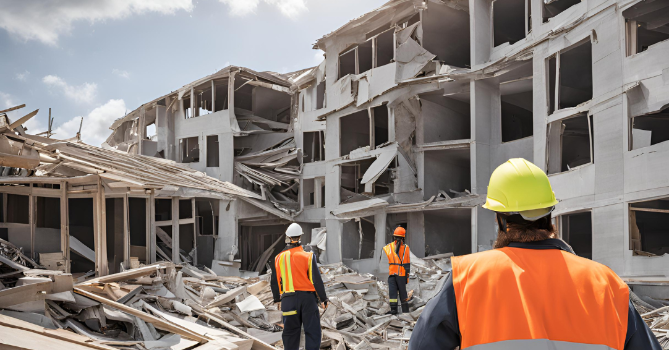.png)
The Importance of BIM in Disaster Resilience Planning
Introduction
With the rising frequency and intensity of natural disasters, the construction industry faces unprecedented challenges in safeguarding infrastructure and communities. Building Information Modeling (BIM) stands out as a transformative tool in disaster resilience planning. By integrating detailed 3D models, real-time data, and advanced analytics, BIM enables accurate risk assessments and scenario planning. This proactive approach enhances the durability of buildings, optimizes emergency response strategies, and supports efficient recovery efforts. Leveraging BIM in disaster resilience planning not only minimizes risks but also ensures that communities are better prepared for future emergencies.
Understanding BIM’s Role in Disaster Resilience
Building Information Modeling (BIM) plays a pivotal role in disaster resilience by offering detailed 3D models that incorporate data on materials, design, and geography. These models provide a comprehensive view of a building's structure and its surrounding environment, making it easier to identify potential vulnerabilities and evaluate risk factors.

BIM’s integration of geographic and environmental data enables the simulation of disaster scenarios, such as earthquakes, floods, and hurricanes, to predict potential damage and develop proactive strategies. Planners and engineers can analyze how different building components will react under stress, allowing for the implementation of reinforcements or design adjustments that improve resilience.
In emergency response planning, BIM’s data-rich environment supports the creation of optimized evacuation routes, emergency service access points, and staging areas for relief operations. The centralized nature of BIM data also facilitates seamless collaboration among stakeholders, including architects, engineers, and emergency management teams, leading to more efficient decision-making and response efforts.
Additionally, BIM’s visualization capabilities aid in educating communities and stakeholders on disaster preparedness measures, enhancing overall readiness and resilience. This proactive approach minimizes the likelihood of catastrophic failures, ensuring that both buildings and communities are better equipped to withstand and recover from adverse events.
BIM in Disaster Preparedness and Planning
BIM serves as a powerful tool for disaster preparedness by enabling simulations of various scenarios, such as earthquakes, floods, and fires. Through these simulations, BIM models help assess potential impacts, predict how structures will perform, and identify vulnerable areas within buildings and infrastructure. This information is vital in planning for mitigation strategies, reinforcing structural elements, and minimizing damage.

BIM also facilitates the development of effective emergency response strategies. With data-rich 3D models, architects and emergency planners can design optimized evacuation routes, create safe zones, and identify critical infrastructure that needs additional protection. This level of planning ensures smoother evacuations and faster emergency response during actual disasters.
Furthermore, BIM’s collaborative environment enables seamless coordination between construction teams, government agencies, and emergency services. Real-time updates to BIM models ensure that emergency responders have access to accurate information regarding building layouts, utility placements, and hazard zones, improving their response efficiency.
For example, in earthquake-prone areas, BIM has been used to design buildings with earthquake-resistant features, while in flood-prone regions, BIM models assist in designing resilient infrastructure. These successful implementations highlight BIM’s crucial role in strengthening community preparedness and enhancing disaster resilience.
BIM in Disaster Response and Real-Time Management
During disaster response, BIM enhances real-time management through its integrated data and communication systems. It offers centralized access to critical building information, enabling emergency teams to make swift and informed decisions. For instance, during evacuations, BIM models can display precise layouts, showing safe routes and emergency exits. This supports seamless coordination among rescue teams, reducing response time and improving safety.

BIM has also been used for infrastructure monitoring, allowing responders to assess structural stability through sensor data integration. Additionally, BIM’s 3D visualization aids in damage assessment by comparing pre- and post-disaster models, helping prioritize repairs and allocate resources effectively. This capability was crucial in managing emergency responses where BIM models were used to monitor flood-prone zones and guide restoration efforts. Overall, BIM’s real-time capabilities transform disaster response by providing actionable insights and enhancing coordination among stakeholders.
BIM for Post-Disaster Recovery and Reconstruction
BIM is invaluable in post-disaster recovery by enabling precise damage assessment and streamlining the reconstruction process. With its detailed 3D models, stakeholders can compare pre- and post-disaster conditions to identify structural damages and prioritize repairs. This information helps create efficient recovery plans, reducing time and costs.

BIM data also facilitates smoother insurance claims by providing accurate documentation of asset conditions and damage levels. Insurers can use BIM models to verify claims, expediting the reimbursement process. Additionally, during reconstruction, BIM ensures compliance with updated building codes and safety regulations by integrating the latest standards into project designs. This proactive approach helps communities rebuild stronger and more resilient structures, enhancing long-term safety and sustainability. Through its comprehensive capabilities, BIM supports a quicker, more organized recovery, allowing affected regions to bounce back effectively from disasters.
Global Examples: Use BIM for Disaster Resilience
Countries like Japan and the USA have successfully leveraged BIM to manage disaster risks and enhance infrastructure resilience. In Japan, a country frequently impacted by earthquakes, BIM has been used to design buildings with advanced seismic resistance. BIM’s data-driven simulations allow engineers to analyze how structures will behave during tremors, enabling proactive reinforcements and improving safety standards.
In the USA, BIM played a critical role in flood-prone areas such as Louisiana. After major flooding events, BIM models were utilized to redesign levees and optimize flood control systems, ensuring that future infrastructure is better equipped to handle extreme weather conditions. These implementations demonstrate BIM’s adaptability in addressing diverse natural hazards and emphasize its potential to be transferred to other regions facing similar risks, aiding in global disaster resilience efforts.
Conclusion: Shaping a Safer Future with BIM
BIM’s comprehensive capabilities make it a critical tool for enhancing disaster resilience in construction. From planning and preparedness to real-time response and post-disaster recovery, BIM enables informed decision-making and efficient management throughout the entire disaster lifecycle. Its application in global case studies demonstrates its adaptability and effectiveness in reducing risks and safeguarding communities. To build a safer future, construction professionals should integrate BIM into their projects and strategies, improving their ability to withstand and recover from natural calamities. Embrace BIM today to strengthen resilience and protect what matters most.